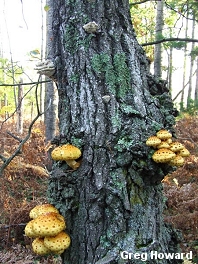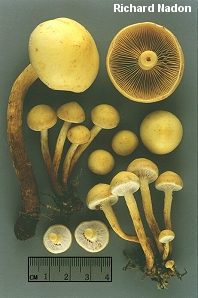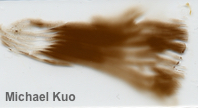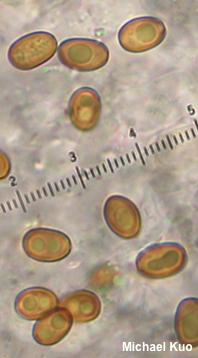| Major Groups > Gilled Mushrooms > Dark-Spored > Pholiota |

|
The Genus Pholiota [ Basidiomycetes > Agaricales > Strophariaceae . . . ] by Michael Kuo Most members of the genus Pholiota are wood-rotting saprobes with brown to cinnamon brown or rusty brown spore prints, gills that are attached to the stem but do not run down it, and rings or ring zones. The most commonly collected species are large, showy mushrooms that feature scaly and/or slimy caps. However, the features above will not always separate pholiotas from other brown-spored, wood rotting mushrooms--and "terrestrial" pholiotas that decompose buried or burned wood are not infrequently found. Ultimately, microscopic features (smooth spores that usually feature a pore, and a filamentous pileipellis) may have to be confirmed. In my area (central Illinois) pholiotas are usually found in colder weather, in fall or spring--but in northern and montane regions they can also be found during summer, while in warmer climates they are also found in winter. Pholiota has been the focus of two major North American monographs (Overholts, 1927; Smith & Hesler, 1968) that based species on observable differences in physical features (in the case of Smith & Hesler, the differences are often microscopic)--but several interesting "mating studies" have also been applied to pholiotas (Farr and collaborators, 1977; Jacobsson, 1987, 1989, 1990; Klan and collaborators, 1989), painting a rather different portrait of species in the genus. Contemporary DNA studies have yet to address the genus with much sustained focus, to my knowledge (see below). I see this state of affairs as exciting, rather than frustrating, since the groundwork has been established for a well supported, multi-faceted approach to the genus. Traditional identification of pholiotas generally requires microscopic analysis. While naked-eye features may successfully lead to identification of a "field guide species" like Pholiota aurivella, the truth is that Pholiota aurivella required microscopic analysis for accurate separation from other species even in the era before mating studies determined that Pholiota limonella, which may be much more common, is capable of sharing all observable macro- and microscopic features except spore size. If you enjoy microscope work, you'll be happy to know that the preliminary result of mating studies and DNA analysis is that microscopic analysis may still be required to separate species. Below I have provided some corrections and annotations to the Smith & Hesler monograph, which contains several editing errors. If using a microscope doesn't sound like fun to you, I certainly won't blame you if you decide to call it "Pholiota aurivella" and find something else to do. Species Pages: |
© MushroomExpert.Com |
|
To my knowledge no contemporary study has focused on the DNA of pholiotas, aside from a 2003 study (Matsumoto and collaborators) using RFLP technology--generally seen as less reliable than sequencing--to position Asia's Pholiota nameko (see above) within the genus. Representative pholiotas included in Moncalvo and collaborators (2002; a broad survey of diverse mushrooms) were spread across several clades, indicating that the genus as traditionally defined is at least partially artificial. The study's results suggest that Pholiota tuberculosa belongs near Crepidotus and Simocybe; that Kuehneromyces/Pholiota mutabilis belongs in a clade with the non-psychoactive species of Psilocybe; that Romagnesi's concept of the genus Hemipholiota (corresponding to Singer's Pholiota subgenus Hemipholiota), which contains the well known Pholiota destruens, may be correct; that Pholiota oedipus belongs near Tubaria; and that the genus Pholiota (as thus amended) is basal to a clade containing Hypholoma and Stropharia. See the Strophariaceae page for further information. References Adamčik, S., J. Holec, P. Lizon, S. Ripkova & V. Kucera (2006). Notes on taxa of the genus Pholiota described by C. Kalchbrenner. Mycotaxon 97: 5–12. Benedict, R. G., L. R. Brady & D. E. Stuntz (1972). Taxonomic status of Pholiota aurea. Mycologia 64: 1167–1169. Chio, R. E. (1993). Nuevos registros del genero Pholiota (Fungi, Basidiomycotina, Agaricales) en Mexico. Revista Mexicana de Micologia 8: 63–70. Farr, E. R., O. K. Miller Jr. & D. F. Farr (1977). Biosystematic studies in the genus Pholiota, stirps Adiposa. Canadian Journal of Botany 55: 1167–1180. Gierczyk, B., M. Halama, A. Kujawa & M. Zalas (2011). Pholiota limonella—the overlooked species. Fragmenta Floristica et Geobotanica Polonica 18: 147–158. Holec, J. (1998). The taxonomy of Pholiota aurivella and Pholiota adiposa—a return to Batsch and Fries. Czech Mycology 50: 201–222. Holec, J. (2001). The genus Pholiota in central and western Europe. Munich: IHW-Verlag. 220 pp. Jacobsson, S. (1987). On the correct interpretation of Pholiota adiposa and a taxonomic survey of section Adiposae. Windhalia 17: 1–17. Jacobsson, S. (1989). Studies on Pholiota in culture. Mycotaxon 36: 95–145. Jacobsson, J. (2018). Pholiota P. Kumm. In Knudsen, H. & J. Vesterholt, eds. Funga Nordica: Agaricoid, boletoid, clavarioid, cyphelloid and gastroid genera. Copenhagen: Nordsvamp. 955–962. Klan, J., D. Baudisova & I. Rulfova (1989). Cultural, enzymatic and cytological studies in the genus Pholiota. Mycotaxon 36: 249–271. Kuyper, Th. W. & G. Tjallingii-Beukers (1986). Notes on Pholiota. Persoonia 13: 77–82. Lee, J. W., M. S. Park, J. -H. Park, Y. Cho, C. Kim, C. S. Kim, J. W. Jo & Y. W. Kim (2020). Taxonomic study of the genus Pholiota (Strophariaceae, Basidiomycota) in Korea. Mycobiology 48: 476–486. Matsumoto, T., Y. Obatake, Y. Fukumasa-Nakai & E. Nagasawa (2003). Phylogenetic position of Pholiota nameko in the genus Pholiota inferred from restriction analysis of ribosomal DNA. Mycoscience 44: 197–202. Moncalvo, J. M., et al. (2002). One hundred and seventeen clades of euagarics. Molecular Phylogenetics and Evolution 23: 357–400. Noordeloos, M. E. (1999). Pholiota. In Bas, C., Th. W. Kuyper, M. E. Noordeloos & E. C. Vellinga. Flora Agaricina Neerlandica: Critical monographs on families of agarics and boleti occurring in the Netherlands. Volume 4. Rotterdam: A. A. Balkema, 80–107. Overholts, L. O. (1927). A monograph of the genus Pholiota in the United States. Annals of the Missouri Botanical Garden 14: 87–211. Redhead, S. A. (1984). Mycological observations, 4–12: on Kuehneromyces, Stropharia, Marasmius, Mycena, geopetalum, Omphalopsis, Phaeomarasmius, Naucoria, and Prunulus. Sydowia 37: 246–270. Siegel, N., N. H. Nguyen & E. C. Vellinga (2015). Pholiota olivaceophylla, a forgotten name for a common snowbank fungus, and notes on Pholiota nubigena. Mycotaxon 130: 517–532. da Silva, P. S., V. G. Cortez & R. M. B. da Silveira (2012). Synopsis of the Strophariaceae (Basidiomycota, Agaricales) from the Floresta Nacional de São Francisco de Paula, Rio Grande do Sul State, Brazil. Hoehnea 39: 479–487 Singer, R. & Smith, A. H. (1946). The taxonomic position of Pholiota mutabilis and related species. Mycologia 38: 500–523. Smith, A. H. & L. R. Hesler (1968). The North American Species of Pholiota. New York: Hafner. 402 pp. I have provided some corrections and annotations to this monograph below. Tian, E. & P. B. Matheny (2021). A phylogenetic assessment of Pholiota and the new genus Pyrrhulomyces. Mycologia 113: 146–167. Some Corrections and Annotations to Smith & Hesler's 1968 Pholiota Monograph Working with this monograph can be frustrating, in part due to errors that appear to result from editing. I have made the "corrections" below in an attempt to make the monograph less frustrating for others--but I hasten to add that 1) I could be wrong, and 2) I am "correcting" the book's editing, not the science of Smith and Hesler. Key to Subgenera, p. 38:
Subg. Flammula
5 Section Adiposae, p. 192:
Stirps Squarrosoides, p. 193
Stirps Adiposa, p. 205 Subgenus Flammuloides, p. 230:
This site contains no information about the edibility or toxicity of mushrooms. Cite this page as: Kuo, M. (2007, November). The genus Pholiota. Retrieved from the MushroomExpert.Com Web site: http://www.mushroomexpert.com/pholiota.html |



